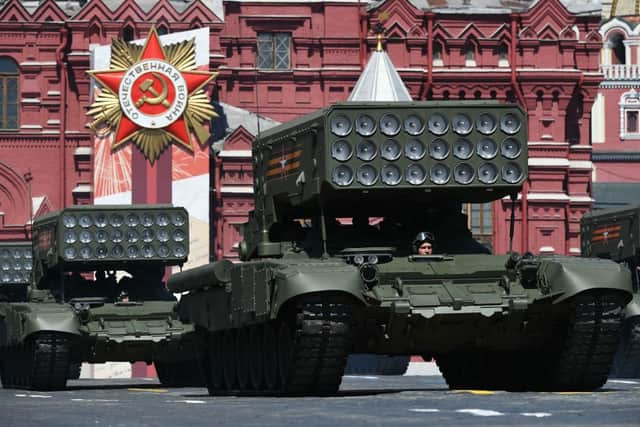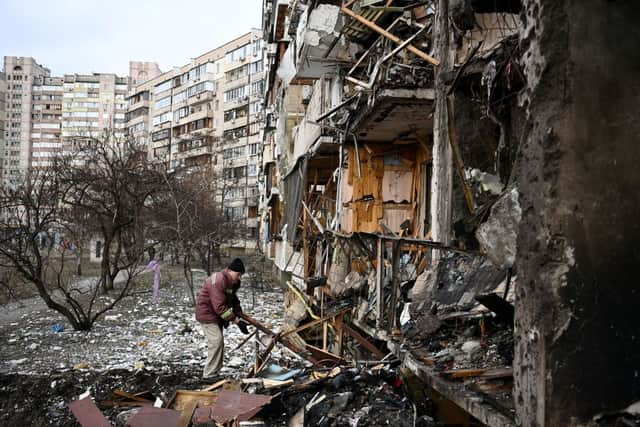Vacuum bomb: what is a thermobaric weapon, has Russia used them in Ukraine, how do they work - and effects
This article contains affiliate links. We may earn a small commission on items purchased through this article, but that does not affect our editorial judgement.
and live on Freeview channel 276
The West fears Vladimir Putin will resort to “barbaric tactics” as his forces close in on Ukraine’s capital.
Western allies have previously expressed fears that Russia could use thermobaric weapons against Ukrainian forces if they continue to hold up their advance.
Advertisement
Hide AdAdvertisement
Hide Ad“I fear that [Putin] is prepared to use the most unsavoury means in this war,” Foreign Secretary Liz Truss told Sky News’s Trevor Phillips on Sunday (27 February) programme.
Asked about Russia’s arsenal of chemical and tactical nuclear weapons, she said: “I fear this conflict could be very, very bloody.”
It’s not just nuclear weapons that are a worry; Russia has a stockpile of chemical weapons and powerful ballistics which could also decimate large civilian populations,
One feared weapon that could be put to use is the thermobaric “vacuum bomb”.
Advertisement
Hide AdAdvertisement
Hide AdBut what exactly is a vacuum bomb, why would their use be frowned upon, and how do they work?
Here is everything you need to know.
How do they work?
A thermobaric weapon is a type of explosive device that uses oxygen from the surrounding air to generate a high-temperature explosion.
Most conventional explosives are triggered when an oxidiser mixes with the bomb’s fuel, causing a heat-driven chemical reaction and therefore an explosion.


Traditional bombs store both their fuel and the oxidiser within a contained device, with a “premix” of the two substances consisting of around 25% fuel to 75% oxidiser.
Advertisement
Hide AdAdvertisement
Hide AdThermobaric weapons are able to carry a payload that is nearly 100% fuel, since the oxidiser they use is the atmosphere around them when they are detonated.
This fuel is dispersed from the device, forming a large cloud of flammable dusts and droplets which is then ignited.
The speed of the ignition - over a much wider area than that within a “traditional” contained explosive device - creates pressure waves which cause additional damage to the heat of the rapidly burning fuel.
Though by design they cannot be used under water, at high altitude or in adverse weather conditions, thermobaric bombs are particularly effective against reinforced buildings and equipment, as their clouds of fuel “flow” around objects and into structures before being ignited.
Advertisement
Hide AdAdvertisement
Hide AdThe blast wave typically produced by these weapons lasts significantly longer than that of a conventional condensed explosive, and a rapid cooling of gases and a drop in pressure following explosions leads to a vacuum of sorts, causing further damage and lending the weapons their misnominal nickname.
Why are they frowned upon?
Obviously, any weapon which results in the loss of life - civilian or otherwise - should be condemned completely.
But some weapons use particularly unpleasant and violent methods to dispatch their targets, cause widespread carnage, and leave lasting effects that inflict pain and suffering long after any conflict is over.


The effects of a thermobaric weapon are horrific - those caught in the immediate explosion could be considered the “lucky” ones, but those further out would suffer a horrendous final few moments.
Advertisement
Hide AdAdvertisement
Hide AdA 2000 Human Rights Watch report found that what kills is the bomb’s pressure wave and the vacuum it leaves, which ruptures the lungs.
According to a US Central Intelligence Agency study, those closest to the immediate explosion are “obliterated”, but victims on the fringe of the weapons’ effects suffer internal injury, “including burst eardrums and crushed inner ear organs, severe concussions, ruptured lungs and internal organs, and possibly blindness.”
Another Defence Intelligence Agency document speculated that, because the shock and pressure waves of the blast actually cause minimal damage to brain tissue, “it is possible that victims are not rendered unconscious by the blast, but instead suffer for several seconds or minutes while they suffocate”.
Since thermobaric bombs are reliant on atmospheric pressure and balanced chemical reactions, they are relatively more likely to “fail” than other more traditional explosives, and it is possible for the fuel of a vacuum bomb to ignite, but not detonate, for instance.
Advertisement
Hide AdAdvertisement
Hide AdIn these cases, “victims will be severely burned and will probably also inhale the burning fuel”, and since the most common fuels for such weapons are highly toxic, even undetonated fuel is considered as lethal to personnel “as with most chemical agents.”
Have they been used in Ukraine?
Russia is known to have thermobaric weapons in its armoury, and has used them in past conflicts, but at the time of writing (1 March) their use in Russia’s invasion of Ukraine has not been confirmed.
However, Oksana Markarova – the Ukrainian ambassador to the US - has claimed that Russia has used such a weapon in the conflict.
She did not say where, but Markarova told reporters: “They used the vacuum bomb today, which is actually prohibited by the Geneva convention.
Advertisement
Hide AdAdvertisement
Hide Ad“The devastation that Russia is trying to inflict on Ukraine is large. But Ukrainians will resist, we are defending our home, we do not have any other option.”
Liz Truss has said any use of these weapons would represent an “extremely serious escalation” of the conflict which could see Russian leaders brought before the International Criminal Court.
Prime Minister Boris Johnson has warned that Vladimir Putin is using “barbaric and indiscriminate tactics against innocent civilians”, and that the Russian President is prepared to “bomb tower blocks, to send missiles into tower blocks, to kill children, as we are seeing in increasing numbers”.
A message from the editor:
Thank you for reading. NationalWorld is a new national news brand, produced by a team of journalists, editors, video producers and designers who live and work across the UK. Find out more about who’s who in the team, and our editorial values. We want to start a community among our readers, so please follow us on Facebook, Twitter and Instagram, and keep the conversation going. You can also sign up to our newsletters and get a curated selection of our best reads to your inbox every day.
Comment Guidelines
National World encourages reader discussion on our stories. User feedback, insights and back-and-forth exchanges add a rich layer of context to reporting. Please review our Community Guidelines before commenting.
